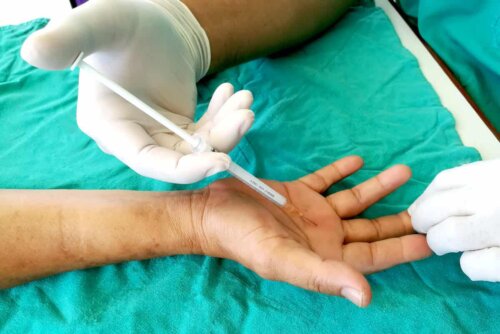What's a Subcutaneous Injection and How to Administer It?


Written and verified by the doctor Leonardo Biolatto
A subcutaneous injection is quite a common occurrence in the medical world. The reason is that the patient is able to administer it themselves, like with insulin for those with diabetes.
A subcutaneous injection is injected into the fatty subcutaneous tissue. In other words, it goes into the layer of fat that we find between the skin and the muscle. This tissue contains little blood vessels, which is why it’s suitable for small volumes of drugs.
Additionally, specialists advise that the medication should be slow absorbing and continuous. Although it’s easy to use, it’s important to remember certain aspects of this kind of administration.
What is a subcutaneous injection?
Subcutaneous injections are often confused with intradermic injections. The latter refers to an injection where the needle only penetrates the dermis (the middle layer of the skin).
Similar to the subcutaneous kind, it’s good for products that absorb slowly and locally. The difference between both is the depth and the angle that it goes in. In the intradermic kind, the needle goes in at an angle of 10 degrees, almost parallel to the skin.
Subcutaneous injections, however, are those where the needle penetrates the subcutaneous tissue. We can find this tissue between the skin and the muscular layer. It’s also known as fatty tissue.
Specialists use this area to administer medication in small volumes. In fact, it’s usually in quantities less than 1 milliliters, although it can reach up to 2 milliliters. Because it’s a tissue with few blood vessels, the body is able to absorb any medication from here in a gradual way.
This is one of the key differences when comparing this kind of injection with intravenous ones; intravenous injections have a quicker effect. Also, subcutaneous injections are easier to administer and are cheaper. One of the main uses is for drugs that someone can’t take orally.

You may also be interested in: 4 Types of Injections You Should Know About
Tips before doing a subcutaneous injection
Before administering a subcutaneous injection, you should keep a few things in mind. As an article published in Nursing explains, you shouldn’t inject irritating medicines. This can cause abscesses or even tissue necrosis to develop.
Contrary to other injections, you should inhale after inserting the needle. This is a gesture that usually helps to check if the needle in intravenous injections is properly located. However, it can leave a bruise.
Additionally, specialists advise against massaging the area where you had the injection. This can cause the body to absorb the drug quicker, which isn’t what we want here.
It’s best to vary the place where you have the injection in case you need to do it continuously. For example, this is what happens with insulin for those who have diabetes. This way we can prevent wounds from forming.
The areas should be separated by a couple of inches. With insulin, we recommend you administer it in circles to change the area where you inject yourself.
Materials for subcutaneous injections
To administer a subcutaneous injection, you need different materials. The first is the syringe. This comes in three parts: needle, barrel, and plunger. The needle is the part that should penetrate the skin, whilst the barrel is where you put the medicine. The plunger helps to introduce and extract the medicine from the syringe.
Syringes can vary a little, but all have readings that help you to know how many fluid ounces (or international units) you’re going to use.
To carry out the subcutaneous injection, you should use a new needle every time. They should be the right size. It’s best to use disposable gloves when handling the needle or syringe because this reduces the risk of infection.
Specialists recommend that you have sterilized tissue at home to use as a surface to place all the materials onto. Also, having disinfectant alcohol or alcohol wipes is a good idea.
You may also be interested in: What You Should Know About the Birth Control Shot
How far should the needle go in?
A subcutaneous injection should have a certain depth and a suitable angle. You can apply it at 90 degrees (perpendicular) or at 45 degrees. You should do it at the first angle when you’re able to, and at a 45-degree angle for those areas or people that have little fatty tissue.
According to a publication in Murcia Salud, it’s not always necessary to clean the skin before the injection. You should only do it in cases where the skin is visibly dirty.
It’s also important to prepare the syringe before the process. You should apply it with your dominant hand, between the thumb and index finger. With the other hand, you need to grab the portion of skin where you’ll administer the injection.
As a Kaiser Permanente article explains, you need to push the needle in with force. When it’s completely in, push the plunger so that the drug enters your body. After that, remove the needle at the same angle you put it in at.
Once this is done, you can let go of your skin with the other hand. You may bleed a little from where you’ve had the injection. In this case, simply apply a little pressure with a cotton pad, or gauze may even be enough.

Where can you have a subcutaneous injection?
You can administer a subcutaneous injection in different areas of your body. One of the most common areas for this is the abdomen. You should insert the needle 2 inches away from the navel, avoiding getting too close. You should also avoid putting pressure on the hip bones or ribs.
Another area where you can have a subcutaneous injection is in the leg. Specifically, the outer area of the thigh, between the knee and the hip.
The lower part of your back, just above your glutes, is another area you can use. In this case, you should ensure that the injection is below your waist and above an imaginary line that rests just above your glutes. Lastly, you can also have it in your arm.
Learning to do it reduces the risks
So, in summary, a subcutaneous injection is a type of injection that you administer to the fatty tissue situated between the skin and the muscle. People often use it to administer small volumes of medication. These medications are also ones that require a slow and gradual absorption rate.
One of the main uses is to administrate insulin. To do it properly, we recommend you change the place you inject yourself and correctly prepare the materials. Similarly, it’s fundamental to follow the best sterile and antiseptic conditions.
All cited sources were thoroughly reviewed by our team to ensure their quality, reliability, currency, and validity. The bibliography of this article was considered reliable and of academic or scientific accuracy.
- Cómo administrar una inyección subcutánea: Instrucciones de cuidado | Kaiser Permanente. (n.d.). Retrieved May 13, 2021, from https://espanol.kaiserpermanente.org/es/health-wellness/health-encyclopedia/he.cómo-administrar-una-inyección-subcutánea-instrucciones-de-cuidado.abl4055
- Cómo administrar una inyección subcutánea | Nursing. (n.d.). Retrieved May 13, 2021, from https://www.elsevier.es/es-revista-nursing-20-articulo-como-administrar-una-inyeccion-subcutanea-13076902
- Preevid: ¿Cuál es la técnica correcta de inyección subcutánea? (n.d.). Retrieved May 13, 2021, from https://www.murciasalud.es/preevid/18156
This text is provided for informational purposes only and does not replace consultation with a professional. If in doubt, consult your specialist.








